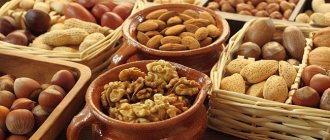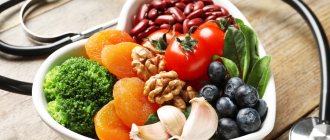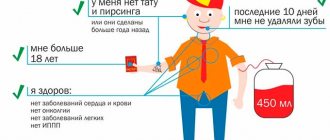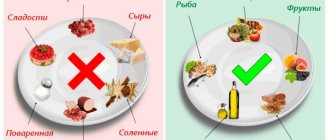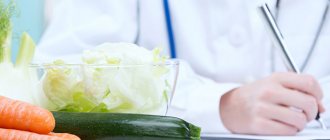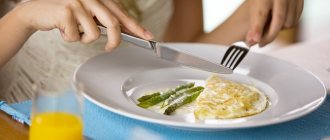The text is for informational purposes only. We strongly urge you not to use diets, resort to any therapeutic menus or fasting without medical supervision. We recommend reading: “Why you can’t go on a diet on your own.”
Nutrition for hypertension is the most important component of antihypertensive treatment aimed at lowering blood pressure. If you do not control your diet, the disease will only progress. The most common causes of death among hypertensive patients are: pathologies of the heart and blood vessels (stroke, myocardial infarction), renal failure, complications of the nervous system.
The goals of diet therapy: correction of metabolic disorders (especially cholesterol), improvement of the functional state of the heart muscle, normalization of the parameters of the blood coagulation system, increasing the elasticity of blood vessels, increasing the synthesis of neuroregulatory hormones (serotonin and dopamine, which prevent mood swings).
General rules
blood pressure depends on many factors, and the physiological mechanisms of self-regulation in the vast majority of cases make it possible to neutralize the effect of negative factors that contribute to increased blood pressure. However, with prolonged and pronounced influence, a failure occurs in the adaptive capabilities of the cardiovascular system, which leads to the development of hypertension - a persistent chronic increase in blood pressure. These factors include:
- physical inactivity;
- bad habits (alcohol abuse/smoking);
- unbalanced diet;
- excess body weight;
- functional, caused by stress/pathological disorders in the central nervous system (in the sympathetic-adrenal system);
- toxic effects of various physical/chemical environmental factors;
- violation of the ratio/production of biologically active substances and hormones involved in the regulation of blood pressure ( endothelins , vasopressin , insulin , prostacyclin , thromboxane , nitric oxide ), responsible for relaxation/increasing the tone of vascular smooth muscles;
- changes in the regulation of water/sodium ion balance in kidney diseases.
The danger of high blood pressure is that in most cases it does not manifest itself clinically for a long period, which leads to the development of ischemic heart disease (coronary heart disease ), hypertrophy of the left ventricle of the heart, cerebral stroke , arrhythmia, CHF (chronic heart failure), functioning of the kidneys and other internal organs. Treatment of the disease is largely determined by the stage of hypertension, but in any case, therapy should be systemic, comprehensive and continuous.
Along with drug treatment, proper nutrition for high blood pressure is the most important factor in stabilizing blood pressure and lowering it to the age norm. The basis of therapeutic nutrition for hypertension is a variety of therapeutic table No. 10 according to Pevzner. As a rule, the diet for hypertension in the initial stage (grade 1) is based on Diet No. 15 with a restriction of table salt. For grade 2 or 3 hypertension and concomitant disorders of the cardiovascular system, Diet No. 10 A . In case of hypertension of moderate/high severity (grade 3/2), occurring against the background of atherosclerosis, nutrition is based on the treatment No. 10 C.
Diet number 10 for hypertension provides for the physiological norm of the intake of basic food nutrients into the body and the creation of conditions for the normalization of blood circulation.
The basic principles of the basic treatment table are:
- Physiologically complete content of the protein component (85-90 g of proteins), 80 g of fat and 350/400 g of carbohydrates with the energy value of the diet at the level of 2400-2500 kcal/day for patients with normal body weight. In case of obesity and hypertension , the energy value of the diet is reduced by 25-30% to 1900-2100 kcal/day by reducing fats to 70 g and carbohydrates to 250-300 g, primarily by eliminating refined carbohydrates from the diet, especially sugar and confectionery/ sweets based on it, as well as flour and cereal products. In cases where obesity due to increased caloric content of food exceeds 20 percent or more of the physiological norm, a therapeutic Diet for hypertensive patients No. 8 according to Pevzner is prescribed for weight loss, but with a significant restriction in the diet of table salt. The antihypertensive effect of weight loss in patients with obesity and hypertension is beyond doubt, and there is even a reliable pattern between weight loss in obesity and a decrease in blood pressure, most often in the proportion of 1 mm Hg. Art./1 kg.
- Limit table salt to 2.5-5 g/day. When cooking, salt is not used, but is added only to ready-made dishes. The average consumption of dietary sodium in Russia is 160 mmol/day, which corresponds to approximately 12 g of table salt. It has been proven that reducing this value below 7.5 g/day leads to a clinically significant decrease in blood pressure. To do this, it is enough to exclude obviously over-salted foods from the diet, especially gastronomic products (canned products, pickles, marinades, smoked meats, sausages, cheeses). For those people who experience severe difficulties from a lack of salt, it is recommended to replace sodium chloride salts with potassium/magnesium chlorides. People with mild forms of arterial hypertension can use medicinal salt with a sodium content reduced to 65%, and in more severe cases, salt with 35% sodium content.
- Increased levels of vitamins A , E , C , group B and minerals - potassium salts (up to 4-5 g), calcium, magnesium (up to 0.8-1.0 g), manganese (up to 30 mg), chromium (up to 0 .3 mg), coenzyme Q (up to 200 mg), vitamin C (up to 500 mg), choline (up to 1 g). It is especially important to control the level of potassium in your diet. There is reliable evidence that increased consumption of potassium ions is extremely important for lowering blood pressure, since potassium has a protective effect against hypertension. Therefore, your diet should include fresh berries and vegetables (baked potatoes, currants, lingonberries, bananas, carrots, cabbage, radishes, garlic, zucchini, tomatoes, pumpkin, beets, cucumbers, beans, oranges, watermelons, seaweed, melons), dried fruits (raisins, dried apricots, prunes, figs), nuts (pine nuts, almonds, peanuts), which are rich in potassium.
- It is important to avoid magnesium deficiency in the diet, which has a pronounced preventive effect against vascular hypertension. Magnesium is found in large quantities in rice, bananas, avocados, seaweed, rolled oats, bran, nuts, yogurt, beans, and prunes. The diet of patients with hypertension should be enriched with calcium ions, which takes part in the distribution of intracellular/extracellular fluid that regulates blood pressure levels. Large quantities of calcium are found in dairy products, nuts, and fish bones. Folate (B vitamin) has a pronounced therapeutic and preventive effect on hypertension It normalizes vascular endothelial function by reducing homocysteine and reduces the risk of developing hypertension. Tomatoes, legumes, leafy vegetables, asparagus, grain products, Brussels sprouts, and fruits are rich in folate.
- carnitine , also exhibits a moderate hypotensive effect . Contained in liver, veal, beef, cream, sour cream, cottage cheese.
- The risk of developing hypertension is also associated with a deficiency of chromium and selenium in the diet. Selenium is contained in foods such as seafood, duck liver, turkey, chicken, beef, beef and veal kidneys. Sources of chromium are corn/sunflower oil, cereals (buckwheat, corn, pearl barley, millet), nuts, dried fruits, vegetables, cheese. Thus, by consuming certain foods that lower blood pressure, it is possible to maintain acceptable blood pressure levels in patients, especially those diagnosed with primary hypertension. In addition, products that lower blood pressure, unlike medications, act very gently.
- Limiting saturated fats in the diet and ensuring a sufficient content of foods containing PUFAs (polyunsaturated fatty acids) from which prostaglandins , which have a hypotensive effect and which can improve endothelial function and blood rheological parameters. To do this, your diet should include fish oil, flaxseed/rapeseed/olive oil (at least 30 g/day), fatty sea fish (salmon, trout, herring, sardines), nuts and seeds.
- The most important component of the diet of people prone to/suffering from hypertension is to provide the body with the necessary amount of free fluid, since with its deficiency in the body, the lumens of blood vessels narrow, which is accompanied by an increase in blood pressure. The daily volume of free fluid should be 1.2-1.5 liters. However, with hypertension combined with heart failure, the volume of free fluid will decrease to 0.8-1.0 l/day. The consumption of carbonated drinks and sodium mineral waters, strong tea and black coffee is prohibited.
- A diet for high blood pressure involves limiting the consumption of alcoholic beverages: for women the equivalent of up to 20 g, for men - up to 40 g of ethyl alcohol. There are differences of opinion regarding the protective effect of low doses of alcohol in relation to cardiovascular diseases. There is no doubt that significant doses of strong alcohol cause the development of hypertension and in high blood pressure alcohol is contraindicated, especially in liver diseases with impaired blood flow in the hepatic veins/inferior vena cava system with increased hydrostatic pressure in the portal vein (portal hypertension). However, there is no data on the benefits of completely abstaining from alcohol. We can mention the French paradox, when residents of France have significantly lower mortality rates from cardiovascular diseases, including hypertension, with the same consumption of animal fats as residents of Central and Northern Europe, but regularly consume small doses of dry red wine.
- Small (4-5 meals a day) meals without overeating.
If arterial hypertension occurs against the background of atherosclerosis , dietary Table No. 10 C . A low-cholesterol diet for patients with hypertension involves reducing animal fats in the diet, eliminating the intake of cholesterol and easily digestible carbohydrates from food. At the same time, an increase in the diet of foods containing dietary fiber, polyunsaturated fatty acids (vegetable fats) and the proportion of plant proteins in relation to animals is provided. The diet for arterial hypertension involves increasing the content of vitamins C and group B , microelements, lipotropic substances/ linoleic acid .
Clinical picture
Hypertension is a pathology of the cardiovascular system, characterized by a persistent increase in blood pressure. Today, every third person on the planet suffers from the disease (mostly people in the older age group).
Content:
- Clinical picture
- Basic principles of nutrition
- Products that lower blood pressure
- Sample menu
- Bee products against hypertension
- Conclusion
The unit of measurement for blood pressure is considered to be millimeters of mercury. The value of arterial indicators is expressed by two numbers: the larger (systolic) and the smaller (diastolic). Moreover, the first value is recorded during maximum contraction of the heart muscle, and the second - at the moment of complete relaxation of the myocardium.
Normally, systolic pressure varies between 100 - 125 millimeters of mercury, diastolic in the range of 70 - 85. If these indicators exceed 140 (upper) and 90 (lower) units, arterial hypertension occurs.
In the pharmaceutical industry, it is customary to distinguish between 3 degrees of severity of pathology.
Mild (preclinical)
This stage of the disease is characterized by frequent abrupt pressure drops (short-term). At the same time, the systolic indicator varies in the range of 140 - 159 units, and the diastolic in the range of 90 - 99 units.
To correct preclinical hypertension, it is advisable to use folk remedies (since medications are not required).
Moderate (borderline)
The second degree of pathology is accompanied by an increase in upper pressure to 179 millimeters of mercury, and lower pressure to 109 units.
To reduce arterial values, pharmaceuticals (hypotonic drugs) are used. In the absence of proper therapy, a hypertensive crisis is possible, since the indicators remain at the borderline (upper) level for a long time.
Severe (chronic)
At the 3rd stage of the disease, systolic pressure exceeds 180 units, and diastolic pressure exceeds 110. Arterial parameters can only be stabilized with the help of medications.
If the disease is not stopped for a long time, irreversible changes develop in the “target organs” (kidneys, heart, brain, fundus vessels). At the same time, uncontrolled hypertension entails severe complications (strokes, encephalopathy, heart attacks, cognitive disorders, dementia, renal failure, etc.).
Symptoms characteristic of the first two stages of the pathology:
- dizziness;
- tinnitus (fullness);
- headache;
- fatigue;
- irritability;
- puffiness of the face;
- insomnia;
- “double vision”;
- swelling of the eyelids.
At the third stage of pathology, the following disorders occur:
- pain in the heart area;
- nausea;
- feeling of lack of air;
- tachycardia;
- redness of the skin;
- impaired coordination of movements;
- cognitive disorders (decreased memory, attention);
- blurred vision;
- "weakness" in the limbs.
Remember, timely diagnosis of the disease will help avoid serious complications: stroke, heart attack, heart failure.
Authorized Products
The diet for hypertension includes the following in the diet:
- Wheat/rye, whole grain and with added bran bread. It is allowed to eat unpalatable homemade baked goods with added bran and dry biscuits.
- Vegetarian soups with vegetables and well-cooked cereals, with the addition of garden herbs without frying.
- Low-fat varieties of red meat, boiled/baked. And poultry meat, rabbit. In any form of cooking, meat must first be boiled, the broth drained, and cooked in a new portion of water.
- Dishes from sea/river fish and seafood.
- Various seasonal vegetables fresh (potatoes, cabbage, carrots, beets, zucchini, pumpkin, eggplant) or in the form of vegetable stew. Appetizers include seaweed, vinaigrettes seasoned with vegetable oil.
- Fermented milk products with reduced fat content and low-fat cottage cheese, sour cream (only in dishes).
- Soft-boiled chicken eggs - up to 3 pieces per week, milk and tomato sauces with vegetable broth or with the addition of sour cream.
- Cereals (barley, millet, buckwheat) and pasta in the form of porridges, casseroles with vegetables/cottage cheese.
- Butter/vegetable oils for cooking and ready-made dishes.
- Fruits/berries in any form, as well as in compotes, jelly and jellies.
- Drinks include coffee drinks (coffee substitutes), rosehip infusion, weak tea with milk, vegetable/berry juices.
Table of permitted products
| Proteins, g | Fats, g | Carbohydrates, g | Calories, kcal | |
Vegetables and greens | ||||
| greenery | 2,6 | 0,4 | 5,2 | 36 |
| eggplant | 1,2 | 0,1 | 4,5 | 24 |
| zucchini | 0,6 | 0,3 | 4,6 | 24 |
| cabbage | 1,8 | 0,1 | 4,7 | 27 |
| broccoli | 3,0 | 0,4 | 5,2 | 28 |
| boiled cauliflower | 1,8 | 0,3 | 4,0 | 29 |
| bulb onions | 1,4 | 0,0 | 10,4 | 41 |
| carrot | 1,3 | 0,1 | 6,9 | 32 |
| cucumbers | 0,8 | 0,1 | 2,8 | 15 |
| salad pepper | 1,3 | 0,0 | 5,3 | 27 |
| salad | 1,2 | 0,3 | 1,3 | 12 |
| beet | 1,5 | 0,1 | 8,8 | 40 |
| celery | 0,9 | 0,1 | 2,1 | 12 |
| asparagus | 1,9 | 0,1 | 3,1 | 20 |
| tomatoes | 0,6 | 0,2 | 4,2 | 20 |
| Jerusalem artichoke | 2,1 | 0,1 | 12,8 | 61 |
| pumpkin | 1,3 | 0,3 | 7,7 | 28 |
| lentils | 24,0 | 1,5 | 42,7 | 284 |
Fruits | ||||
| avocado | 2,0 | 20,0 | 7,4 | 208 |
| oranges | 0,9 | 0,2 | 8,1 | 36 |
| pomegranate | 0,9 | 0,0 | 13,9 | 52 |
| grapefruit | 0,7 | 0,2 | 6,5 | 29 |
| pears | 0,4 | 0,3 | 10,9 | 42 |
| kiwi | 1,0 | 0,6 | 10,3 | 48 |
| lemons | 0,9 | 0,1 | 3,0 | 16 |
| mango | 0,5 | 0,3 | 11,5 | 67 |
| tangerines | 0,8 | 0,2 | 7,5 | 33 |
| nectarine | 0,9 | 0,2 | 11,8 | 48 |
| peaches | 0,9 | 0,1 | 11,3 | 46 |
| apples | 0,4 | 0,4 | 9,8 | 47 |
Berries | ||||
| gooseberry | 0,7 | 0,2 | 12,0 | 43 |
| Red currants | 0,6 | 0,2 | 7,7 | 43 |
| black currant | 1,0 | 0,4 | 7,3 | 44 |
Nuts and dried fruits | ||||
| nuts | 15,0 | 40,0 | 20,0 | 500 |
| cashew | 25,7 | 54,1 | 13,2 | 643 |
| sesame | 19,4 | 48,7 | 12,2 | 565 |
| flax seeds | 18,3 | 42,2 | 28,9 | 534 |
| fenugreek seeds | 23,0 | 6,4 | 58,3 | 323 |
| sunflower seeds | 20,7 | 52,9 | 3,4 | 578 |
Cereals and porridges | ||||
| buckwheat (kernel) | 12,6 | 3,3 | 62,1 | 313 |
| oat groats | 12,3 | 6,1 | 59,5 | 342 |
| cereals | 11,9 | 7,2 | 69,3 | 366 |
| millet cereal | 11,5 | 3,3 | 69,3 | 348 |
| barley grits | 10,4 | 1,3 | 66,3 | 324 |
Bakery products | ||||
| Rye bread | 6,6 | 1,2 | 34,2 | 165 |
Raw materials and seasonings | ||||
| honey | 0,8 | 0,0 | 81,5 | 329 |
Dairy | ||||
| skim milk | 2,0 | 0,1 | 4,8 | 31 |
| natural yogurt 2% | 4,3 | 2,0 | 6,2 | 60 |
Cheeses and cottage cheese | ||||
| cottage cheese 0.6% (low fat) | 18,0 | 0,6 | 1,8 | 88 |
| curd tofu | 8,1 | 4,2 | 0,6 | 73 |
Meat products | ||||
| beef | 18,9 | 19,4 | 0,0 | 187 |
| rabbit | 21,0 | 8,0 | 0,0 | 156 |
Sausages | ||||
| boiled diet sausage | 12,1 | 13,5 | 0,0 | 170 |
Bird | ||||
| chicken fillet | 23,1 | 1,2 | 0,0 | 110 |
| turkey | 19,2 | 0,7 | 0,0 | 84 |
Fish and seafood | ||||
| fish | 18,5 | 4,9 | 0,0 | 136 |
| squid | 21,2 | 2,8 | 2,0 | 122 |
| mussels | 9,1 | 1,5 | 0,0 | 50 |
| seaweed | 0,8 | 5,1 | 0,0 | 49 |
Oils and fats | ||||
| butter | 0,5 | 82,5 | 0,8 | 748 |
| linseed oil | 0,0 | 99,8 | 0,0 | 898 |
| olive oil | 0,0 | 99,8 | 0,0 | 898 |
| sunflower oil | 0,0 | 99,9 | 0,0 | 899 |
Non-alcoholic drinks | ||||
| mineral water | 0,0 | 0,0 | 0,0 | — |
| green tea | 0,0 | 0,0 | 0,0 | — |
| * data is per 100 g of product | ||||
Fully or partially limited products
Nutritional therapy for hypertension involves excluding from the diet:
- Fresh wheat and rye bread, butter and puff pastry.
- Rich broths from meat/fish, legumes and vegetables.
- Fatty varieties of pork, poultry meat (duck, goose), smoked meats, cooking/animal fats, kidneys, liver, sausages, meat and fish.
- Red caviar, salted and smoked fish, legumes, fish, meat, mushroom sauces, fatty cheese and cottage cheese, cream, sour cream. Sorrel, radish, radish, mushrooms, spinach, mustard, and horseradish are excluded from the diet.
- Ice cream, chocolate, pastries with cream, strong tea and black coffee, cocoa.
- The consumption of salt, pickles, marinades, sugar, honey, jam, grapes, and sodium mineral waters is limited.
Table of prohibited products
| Proteins, g | Fats, g | Carbohydrates, g | Calories, kcal | |
Vegetables and greens | ||||
| vegetables legumes | 9,1 | 1,6 | 27,0 | 168 |
| canned vegetables | 1,5 | 0,2 | 5,5 | 30 |
| sauerkraut | 1,8 | 0,1 | 4,4 | 19 |
| pickles | 0,8 | 0,1 | 1,7 | 11 |
| radish | 1,2 | 0,1 | 3,4 | 19 |
| white radish | 1,4 | 0,0 | 4,1 | 21 |
| red radish | 1,2 | 0,1 | 3,4 | 20 |
| black radish | 1,9 | 0,2 | 6,7 | 35 |
| spinach | 2,9 | 0,3 | 2,0 | 22 |
| sorrel | 1,5 | 0,3 | 2,9 | 19 |
Fruits | ||||
| bananas | 1,5 | 0,2 | 21,8 | 95 |
Berries | ||||
| grape | 0,6 | 0,2 | 16,8 | 65 |
Mushrooms | ||||
| mushrooms | 3,5 | 2,0 | 2,5 | 30 |
Nuts and dried fruits | ||||
| raisin | 2,9 | 0,6 | 66,0 | 264 |
Confectionery | ||||
| candies | 4,3 | 19,8 | 67,5 | 453 |
| pastry cream | 0,2 | 26,0 | 16,5 | 300 |
| shortbread dough | 6,5 | 21,6 | 49,9 | 403 |
Ice cream | ||||
| ice cream | 3,7 | 6,9 | 22,1 | 189 |
Cakes | ||||
| cake | 4,4 | 23,4 | 45,2 | 407 |
Chocolate | ||||
| chocolate | 5,4 | 35,3 | 56,5 | 544 |
Raw materials and seasonings | ||||
| mustard | 5,7 | 6,4 | 22,0 | 162 |
| mayonnaise | 2,4 | 67,0 | 3,9 | 627 |
Dairy | ||||
| milk 3.6% | 2,8 | 3,6 | 4,7 | 62 |
| milk 4.5% | 3,1 | 4,5 | 4,7 | 72 |
| cream | 2,8 | 20,0 | 3,7 | 205 |
| sour cream 25% (classic) | 2,6 | 25,0 | 2,5 | 248 |
Cheeses and cottage cheese | ||||
| cheese | 24,1 | 29,5 | 0,3 | 363 |
| cottage cheese 18% (fat) | 14,0 | 18,0 | 2,8 | 232 |
Meat products | ||||
| pork | 16,0 | 21,6 | 0,0 | 259 |
| pork liver | 18,8 | 3,6 | 0,0 | 108 |
| pork kidneys | 13,0 | 3,1 | 0,0 | 80 |
| pork fat | 1,4 | 92,8 | 0,0 | 841 |
| salo | 2,4 | 89,0 | 0,0 | 797 |
| beef liver | 17,4 | 3,1 | 0,0 | 98 |
| beef kidneys | 12,5 | 1,8 | 0,0 | 66 |
| beef brains | 9,5 | 9,5 | 0,0 | 124 |
Sausages | ||||
| smoked sausage | 16,2 | 44,6 | 0,0 | 466 |
| smoked sausage | 9,9 | 63,2 | 0,3 | 608 |
| sausages | 10,1 | 31,6 | 1,9 | 332 |
| sausages | 12,3 | 25,3 | 0,0 | 277 |
Bird | ||||
| smoked chicken | 27,5 | 8,2 | 0,0 | 184 |
| duck | 16,5 | 61,2 | 0,0 | 346 |
| smoked duck | 19,0 | 28,4 | 0,0 | 337 |
| goose | 16,1 | 33,3 | 0,0 | 364 |
Fish and seafood | ||||
| smoked fish | 26,8 | 9,9 | 0,0 | 196 |
| salted fish | 19,2 | 2,0 | 0,0 | 190 |
| Red caviar | 32,0 | 15,0 | 0,0 | 263 |
| black caviar | 28,0 | 9,7 | 0,0 | 203 |
| canned fish | 17,5 | 2,0 | 0,0 | 88 |
| cod (liver in oil) | 4,2 | 65,7 | 1,2 | 613 |
Oils and fats | ||||
| animal fat | 0,0 | 99,7 | 0,0 | 897 |
| cooking fat | 0,0 | 99,7 | 0,0 | 897 |
Non-alcoholic drinks | ||||
| instant coffee dry | 15,0 | 3,5 | 0,0 | 94 |
| black tea | 20,0 | 5,1 | 6,9 | 152 |
| * data is per 100 g of product | ||||
What to exclude or limit?
Products that increase blood pressure
Patients with high blood pressure are prohibited or limited:
- eggs - fried or boiled until the yolk is firm;
- partially fish menu - fatty fish varieties (Caspian sprat, herring, mackerel, eel, halibut), caviar, as well as those prepared by smoking and canning;
- first courses - broths cooked from fish and meat, as well as mushrooms;
- vegetable preparations - salted and pickled;
- some vegetables and herbs - onions, spinach, rare, radishes, garlic;
- fatty meat - duck, goose, as well as liver, kidneys, other offal, smoked meats, canned goods;
- grape juice;
- flour - fresh, flaky, rich pastries;
- dairy products - fatty (above 40%) and salty types of cheese;
- animal and cooking fats;
- dishes with legumes and mushrooms.
Menu for hypertensive patients (Diet regimen)
The diet for hypertension, the menu for the week are compiled according to the list of permitted products in accordance with the prescribed treatment table. Below is a sample menu for the week:
Monday
| Breakfast |
|
| Lunch |
|
| Dinner |
|
| Dinner |
|
| For the night |
|
Tuesday
| Breakfast |
|
| Lunch |
|
| Dinner |
|
| Dinner |
|
| For the night |
|
Wednesday
| Breakfast |
|
| Lunch |
|
| Dinner |
|
| Dinner |
|
| For the night |
|
Thursday
| Breakfast |
|
| Lunch |
|
| Dinner |
|
| Dinner |
|
| For the night |
|
Friday
| Breakfast |
|
| Lunch |
|
| Dinner |
|
| Dinner |
|
| For the night |
|
Saturday
| Breakfast |
|
| Lunch |
|
| Dinner |
|
| Dinner |
|
| For the night |
|
Sunday
| Breakfast |
|
| Lunch |
|
| Dinner |
|
| Dinner |
|
| For the night |
|
The need to follow a diet
Compliance with the principles of therapeutic nutrition for hypertension will help stabilize blood pressure and manage with a minimum amount of hypotonic drugs.
In addition, a diet for hypertension will help reduce cholesterol levels and lose excess weight, and prevent the development of atherosclerosis. Vitamins and microelements reduce the permeability of the vascular wall, normalize vascular tone and increase immunity. The treatment table for hypertension is the prevention of the development of complications of the disease.
Recipes
First meal
Vegetarian dumpling soup
Vegetable broth, potatoes, flour, 2 chicken eggs, milk, butter, garden herbs.
Prepare vegetable broth, add potatoes. Beat an egg into well-melted butter, add milk, beat, add flour until the dough has a viscous consistency. Take the resulting mass with a teaspoon and lower it into the boiling broth, forming dumplings, boil for 5-7 minutes. Sprinkle with garden herbs before serving.
Second courses
Chicken cutlets
Chicken white/brown meat, white bread, onion, 2 eggs, milk, vegetable oil, flour.
Prepare minced chicken, add egg, bread soaked in milk, onion, chopped herbs. Knead the resulting mass, form into cutlets, roll in flour and bake in the oven until cooked.
Dessert
Rice and carrot pudding
Egg, carrots, rice, butter, breadcrumbs, baking powder, yogurt.
Prepare rice. Grate the carrots, simmer, add rice, rub thoroughly through a sieve. Beat the egg into the resulting mass, add baking powder, breadcrumbs, and melted butter. Stir, place in a baking dish, bake for 40 minutes. Drizzle yoghurt on top.
Comments from nutritionists
Many patients with hypertension are interested in the question of whether it is possible to practice fasting to lose weight. No, high blood pressure and fasting are incompatible, and the recommendations of some authors on the Internet offering fasting treatment and positive reviews about such methods of treating hypertension can only harm your health. Moreover, not only hunger, but any strict diet is contraindicated for hypertensive patients. With a persistent increase in blood pressure, during a hypertensive crisis, two-day fasting diets are advisable: vegetable, cottage cheese, dairy, apple, rice-compote, dried fruit.
DASH Diet
American specialists from the National Institutes of Health have developed a special nutrition system for people suffering from high blood pressure, which is called DASH (Dietary Approaches to Stop Hypertension) - a diet designed to stop hypertension. It must be said that nothing super new was invented - the basic principles are described above, it is necessary to reduce the amount of fat, especially of animal origin.
It is worth noting that if you have hypertension, fasting is strictly prohibited. Therefore, strict fasting or excessive dieting is contraindicated. Another important nuance noted in the DASH system is the mandatory elimination of the bad habit of smoking cigarettes. Nicotine has a strong vasoconstrictor effect, therefore it has the most negative effect on blood pressure.
Reviews and results
Dietary nutrition for hypertension, according to patient reviews, is an effective treatment method that helps normalize blood pressure. In general, the diet is well tolerated, but some patients suffer from low-salt foods, lack of smoked meats, and limiting sugar and sweets.
- “...Initial stage hypertension. After the diagnosis, I was very worried that I would repeat the problems of my parents. They are chronic hypertensives. I studied the literature available to me, re-read the forums on the topic: high blood pressure, nutrition for hypertension. I immediately decided for myself that I would not start the problem. A relative, a general practitioner, described everything to me. She prescribed diet 15, but with a small amount of salt, and advised me to get used to eating everything lightly salted and forget about pickles, marinades, and smoked meats. She also advised me to change my lifestyle, start moving actively, since I work at the computer all day, constantly monitor my weight, and stop even occasional smoking. Almost six months have passed, so far everything is working out, the pressure has been stabilized, and at the same time I have lost weight”;
- “...Hypertensive patient with extensive experience. In addition to taking medications, a low-salt and sometimes salt-free diet is very helpful. At first, I couldn’t get used to eating unsalted food for a long time, I was drawn to the usual sausages and ham, I wanted salted fish and cucumbers. But over time I got used to it, learned to add flavor to dishes with garden herbs, garlic, mild herbal spices, and dried fruits. Now I practically do not suffer from lack of salt. In addition, a salt-free diet helped normalize body weight, and shortness of breath disappeared. I try to lead a healthy lifestyle, practice physical activity (walking in the park), and ride a bicycle. This is how I have maintained my health for almost 10 years.”
General nutritional guidelines for people with hypertension
Often, adjusting your diet is enough to bring your blood pressure back to normal.
With proper nutrition, the condition in some patients stabilizes to such an extent that the doctor can reduce the dose of prescribed medications.
In the diet of a patient with this pathology, the consumption of the following products is reduced or eliminated:
- Salt should not be consumed more than 6-8 g per day. With an excess of sodium chloride, the removal of fluid from the body is delayed, which increases the volume of blood in the vessels. Most foods contain salt, so they don't need to be salted. If the taste seems bland, season the dish with lemon juice, herbs, and mild spices.
- Strongly brewed tea (green, black), coffee, cocoa, drinks containing alcohol cause vascular spasm, as a result of which the heart works more intensely. In addition, they stimulate the nervous system. The possibility of consuming these products is determined in each individual case.
- Animal fats cause the body to produce cholesterol, which clogs blood vessels and limits blood flow to the heart and other internal organs.
- Easily digestible, or fast carbohydrates (sugars) cause obesity.
Foods with potassium to strengthen the heart muscle
Increase the content of the following foods in your diet:
- Plant origin (vegetables, fruits, cereals), since they are rich in dietary fiber (fiber), prevent the absorption of harmful cholesterol and reduce its amount in the blood. Fiber also makes you feel full and prevents overeating.
- Products with magnesium and potassium - minerals that strengthen the heart muscle and increase its endurance.
- Products with vitamin C, which strengthens the walls of blood vessels. To preserve ascorbic acid content as much as possible, reduce the heat treatment time of the product or consume it raw.
Magnesium-rich foods to strengthen your heart muscle

